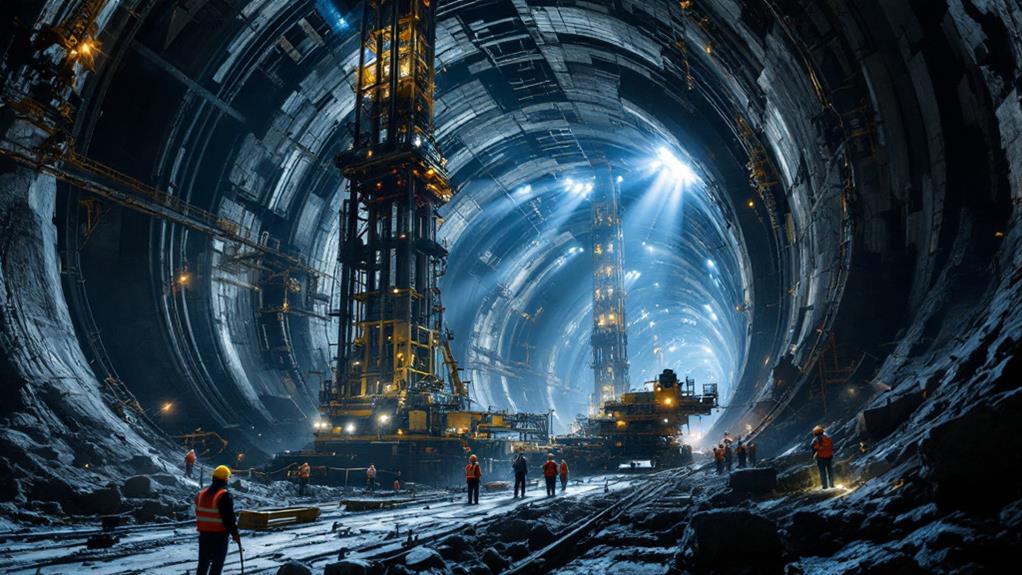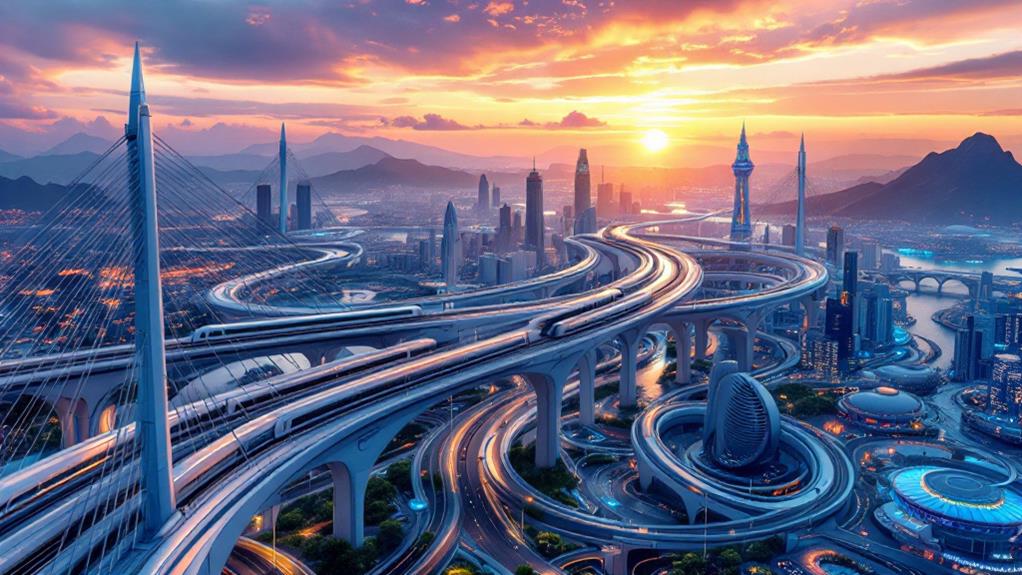The Largest Infrastructure Projects in History: Roads, Bridges, and Tunnels

You're about to uncover some of the largest infrastructure projects in history that have dramatically reshaped transportation and connectivity. The U.S. Interstate Highway System, stretching 41,000 miles, transformed American travel and economics. Iconic bridges like the Golden Gate and Brooklyn Bridge have become engineering marvels and tourist attractions. Meanwhile, tunnels like the Channel Tunnel and Gotthard Base Tunnel redefine international connectivity, cutting travel times drastically. These colossal projects don't just stand as feats of engineering—they're essential to economic growth and increased accessibility. Explore how these grand designs continue to impact the world today and their ongoing influence.
Iconic Road Networks
How did these iconic road networks shape the way we travel today? Imagine driving on a seamless highway, where miles fly by and destinations seem closer. The Interstate Highway System, a monumental public works project, transformed American transportation with its 41,000 miles of roads, enhancing the economy with an impressive $6 return for every $1 spent. It's not just roads; it's a revolution in your quality of life. You can traverse the country more efficiently, connecting cities like never before.
Picture yourself in Los Angeles in the late 1930s. The Arroyo Seco Parkway opened the door to modern freeway travel, cutting your trip from LA to Pasadena to just 12 minutes. This roadway set the stage for future developments in urban commuting. Go back further, and you find the Transcontinental Railroad, which slashed cross-country travel time from months to days, linking the eastern states to the West Coast.
Then there's U.S. Route 66, the "Mother Road," embodying American freedom and mobility, driving westward expansion. As you cruise the Pacific Coast Highway, remember these iconic networks aren't just roads—they're lifelines that shape our travels and enrich our lives.
Remarkable Bridge Constructions
Inspiration and engineering prowess meet in remarkable bridge constructions that have redefined landscapes and connected communities. Imagine standing on the Brooklyn Bridge in New York City, completed in 1883, marveling at its iconic steel-wire suspension design. This remarkable bridge connects Manhattan and Brooklyn, showcasing not just construction brilliance but also becoming a symbol of resilience and innovation.
Fast-forward to 1937, and the Golden Gate Bridge emerges as another engineering triumph. Spanning 1.7 miles, it was the longest and tallest suspension bridge globally at the time, linking San Francisco to Marin County. Its striking red hue and graceful arches continue to captivate millions.
Meanwhile, the Hoover Dam Bypass Bridge, completed in 2010, offers another example of remarkable construction feats. At 890 feet above the Colorado River, it's one of the highest bridges in the U.S., complementing the monumental Hoover Dam itself.
Internationally, the Akashi Kaikyō Bridge in Japan, completed in 1995, surpasses others with its 1.2-mile main span, designed to withstand natural disasters. Likewise, the Millau Viaduct in France, completed in 2004, stands as the tallest bridge in the world, offering a breathtaking travel route between Paris and Barcelona.
Engineering Marvels in Tunneling

Throughout history, engineering marvels in tunneling have pushed the boundaries of what's possible beneath our feet. These infrastructure projects have reshaped how we view transport efficiency and commuter transit. Take the Channel Tunnel, for instance. Completed in 1994, this 31.4-mile marvel connects the UK and France, slashing travel time across the English Channel. It's one of the longest tunnels globally, showcasing the potential of modern engineering.
In Switzerland, the Gotthard Base Tunnel stands as the world's longest railway tunnel at 35.5 miles. Opened in 2016, it improves transport efficiency between Northern and Southern Europe, accommodating both freight and passenger trains. Meanwhile, Japan's Seikan Tunnel, completed in 1988, spans 33.5 miles beneath the sea, linking Honshu and Hokkaido while withstanding seismic activity.
Turkey's Yavuz Sultan Selim Bridge features a tunnel under the Bosphorus Strait, integrating road and rail traffic. Its 2016 completion heralded it as the widest suspension bridge globally. The Marmaray Tunnel, also in Turkey, opened in 2013, is a 13.6-mile rail tunnel that facilitates commuter transit between Europe and Asia, marking it as the initial underwater railway to connect two continents. These projects highlight the construction industry's ability to achieve the extraordinary.
Economic Impacts of Infrastructure
While engineering marvels in tunneling showcase human ingenuity, the true impact of such projects often emerges through their economic contributions. Consider the economic return of infrastructure investments like the Dwight D. Eisenhower System of Interstate and Defense Highways, which generated $6 for every $1 spent. This not only enhanced U.S. commerce but also reshaped travel patterns, driving economic activities across connected regions. Infrastructure projects can act as catalysts, much like during the Great Depression when the construction of the Golden Gate Bridge created jobs and attracted millions of tourists, invigorating the local economy.
When you look at projects like the Panama Canal, costing around $400 billion in current dollars, you see a revolution in global trade by cutting maritime travel distances. Likewise, power plants like the Hoover Dam serve dual purposes, offering renewable energy resources and water systems, crucial for regional economic development. Infrastructure bills often aim to address climate change challenges by promoting sustainable projects. Investing in such infrastructure not only provides immediate economic benefits but also guarantees long-term resilience. By focusing on these projects, you can drive growth, create jobs, and contribute to a sustainable future.
Future of Transportation Projects

Transportation projects are rapidly evolving to meet the demands of a modern world focused on efficiency and sustainability. With the expansion of electric power and cutting-edge infrastructure, the future of transportation is promising. Embracing new technology, upcoming urban transit projects aim to revolutionize your daily commute and promote sustainable transportation.
Consider these exciting developments:
- Electric Power Infrastructure: By 2030, you'll see over 500,000 charging stations installed across the U.S., supporting an ever-growing fleet of electric vehicles. This move not only caters to the rising demand but also greatly reduces carbon emissions.
- Urban Transit Projects: Cities like New York are investing billions in projects such as the Second Avenue Subway. These developments aim to alleviate congestion and improve accessibility, making your urban travel more efficient and less stressful.
- Rail Network Expansion: High-speed rail projects, like California's, are set to connect major urban areas with the power to transport up to 100 million passengers annually. This not only improves connectivity but also offers a sustainable alternative to traditional travel.
These advancements represent a shift towards smarter, more efficient transportation solutions, setting a new standard for urban mobility.



